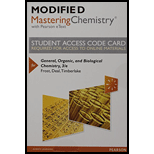
a.
To determine:
The reactant which is oxidized and the reactant which is reduced in the reaction of copper and silver nitrate.
Introduction:
Atoms consist of three subatomic particles namely proton, electron, and neutron. Out of these subatomic particles, only electrons are involved in bonding. The formation of bonds between two species is always due to the involvement of electrons; either it undergoes loss of electrons or gain of electrons.
b.
To determine:
The reactant which is oxidized and the reactant which is reduced in the reaction of aluminum with oxygen.
Introduction:
Atoms consist of three subatomic particles namely proton, electron, and neutron. Out of these subatomic particles, only electrons are involved in bonding. The formation of bonds between two species is always due to the involvement of electrons; either it undergoes loss of electrons or gain of electrons.
c.
To determine:
The species which is oxidized and the species which is reduced in the decomposition of silver bromide.
Introduction:
Atoms consist of three subatomic particles namely proton, electron, and neutron. Out of these subatomic particles, only electrons are involved in bonding. The formation of bonds between two species is always due to the involvement of electrons; either it undergoes loss of electrons or gain of electrons.
Want to see the full answer?
Check out a sample textbook solution
Chapter 5 Solutions
Modified Mastering Chemistry with Pearson eText -- Standalone Access Card -- for General, Organic, and Biological Chemistry (3rd Edition)
- For each reaction, indicate which elements are oxidized and which are reduced: a.2Al+3CU2+2Al3++3Cub.2H++NiNi2++H2c.2I-+Cl2I2+2Cl-arrow_forwardThe Toliens test for the presence of reducing sugars (say, in a urine sample) involves treating the sample with silver ions in aqueous ammonia. The result is the formation of a silver mirror within the reaction vessel if a reducing sugar is present. Using glucose, C6H12O6, to illustrate this test, the oxidation-reduction reaction occurring is C6H12O6 (aq) + 2 Ag+(aq) + 2OH(aq) C6H12O7(aq) + 2 Ag(s) + H2O() What has been oxidized, and what has been reduced? What is the oxidizing agent, and what is the reducing agent? Tolien's test. The reaction of silver ions with a sugar such as glucose produces metallic silver. (a) The set-up for the reaction. (b) The silvered test tubearrow_forwardCopper metal can reduce silver ions to metallic silver. The copper is oxidized to copper ions according to the reaction 2Ag+(aq)+Cu(s)Cu2+(aq)+2Ag(s)A copper strip with a mass of 2.00 g is dipped into a solution of AgNO3. After some time has elapsed, the copper strip is coated with silver. The strip is removed from the solution, dried, and weighed. The coated strip has a mass of 4.18 g. What are the masses of copper and silver metals in the strip? (Hint: Remember that the copper metal is being used up as silver metal forms.)arrow_forward
- Bromine is obtained from sea water by the following redox reaction: Cl2(g) + 2 NaBr(aq) 2 NaCl(aq) + Br2() (a) What has been oxidized? What has been reduced? (b) Identify the oxidizing and reducing agents.arrow_forwardWrite equations for respiration and photosynthesis. For each reaction, label the substances that are oxidized and reduced. Why are these reactions important?arrow_forward
 Chemistry: The Molecular ScienceChemistryISBN:9781285199047Author:John W. Moore, Conrad L. StanitskiPublisher:Cengage Learning
Chemistry: The Molecular ScienceChemistryISBN:9781285199047Author:John W. Moore, Conrad L. StanitskiPublisher:Cengage Learning Introductory Chemistry: A FoundationChemistryISBN:9781337399425Author:Steven S. Zumdahl, Donald J. DeCostePublisher:Cengage Learning
Introductory Chemistry: A FoundationChemistryISBN:9781337399425Author:Steven S. Zumdahl, Donald J. DeCostePublisher:Cengage Learning
- Chemistry: Matter and ChangeChemistryISBN:9780078746376Author:Dinah Zike, Laurel Dingrando, Nicholas Hainen, Cheryl WistromPublisher:Glencoe/McGraw-Hill School Pub Co
 Chemistry & Chemical ReactivityChemistryISBN:9781133949640Author:John C. Kotz, Paul M. Treichel, John Townsend, David TreichelPublisher:Cengage Learning
Chemistry & Chemical ReactivityChemistryISBN:9781133949640Author:John C. Kotz, Paul M. Treichel, John Townsend, David TreichelPublisher:Cengage Learning Chemistry & Chemical ReactivityChemistryISBN:9781337399074Author:John C. Kotz, Paul M. Treichel, John Townsend, David TreichelPublisher:Cengage Learning
Chemistry & Chemical ReactivityChemistryISBN:9781337399074Author:John C. Kotz, Paul M. Treichel, John Townsend, David TreichelPublisher:Cengage Learning





